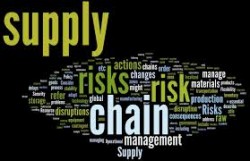Analyzing and Managing Supply Chain Risks
 The financial health of an enterprise today is directly dependent upon the health of their supply chain. With that exposure, it is only prudent to employ a risk management strategy to the supply chain. Sales and Operations Planning is a “must” for progressive enterprises, but its job is to react to changes and retarget to meet customer demand within a constrained supply base ― not to assess risk.
The financial health of an enterprise today is directly dependent upon the health of their supply chain. With that exposure, it is only prudent to employ a risk management strategy to the supply chain. Sales and Operations Planning is a “must” for progressive enterprises, but its job is to react to changes and retarget to meet customer demand within a constrained supply base ― not to assess risk.
Supply chain risk falls into 2 main categories – catastrophic and “common.” Fortunately catastrophic supply chain failure is a low probability, but high-impact situation like 9-11, Katrina, or Ebola. Unfortunately few companies have the preparedness to handle these types of failures; and preventing them in the future requires rethinking and redesign.
The more common failures have a higher probability and lower impact but are still disruptive and can be financially devastating. These failures can be difficult to spot since they occur both directly and indirectly as a gradual decay (such as supplier failures or cost failures via commodity pricing). To detect and correct these more common failures requires developing a supply chain index and then constantly monitoring it over time. The index needs to contain a broad set of measurable metrics that when properly combined gives a good view of risk.
Supply Chain Risk Metrics
- Demand Volatility can include demand forecast error (MAPE), planned causal events such as promotional planning, and even customer profitability assessment. As demand volatility increases so does the risk to customer service unless the volatility can be predicted with an acceptable degree of accuracy.
- Supply Volatility measures the delivery performance of each supplier relative to on-time delivery, lead time and lead time variability. A more indirect metric is the continuing credit rating of each supplier, but perhaps the most telling is changes in lead time ― indicating either internal business problems or problems with the supplier’s suppliers.
- Stored capacity or Inventory is measured by turns, safety stock and days of supply. These metrics are traditional and should be readily available. Lower than optimum levels can indicate a pending customer service problem. Higher than optimum levels can indicate an operational or cost problem.
- Quality Index can include perfect orders, customer product returns and rejects as measured from your customer’s perspective. When measuring your suppliers, these metrics can be informative and blended into the supply volatility metric if available.
- Agility Index is represented by fulfillment cycle time, fixed cost vs. variable costs, lead time and Available-To-Promise. These metrics may be the least important and are sometimes difficult to obtain at a useful level unless other metrics are included in the supply chain risk index.
Supply Chain Risk Index
This is a dimensionless index of continuously monitored supply chain metrics that can be weighted to increase or decrease the impact of each individual metric on the index. The important measurement is the change in the risk index from period to period and then being able to drill down into each metric to determine the root causes.
SC Risk Index = (W1 x D) + (W2 x S) + (W3 x I) + (W4 x Q) + (W5 x A)
W1 through W5 are weighting factors specific to each business for changing the impact of each contributing metric. These metrics include D=Demand volatility, S=Supply volatility, I=inventory, Q=Quality and A= Agility (all of which must be measured from period to period).
Supply chain risk management is employed at some level in every company but the more progressive companies harness technology and data to improve their reaction and response time to supply chain failures. This technology includes an enterprise data repository with user friendly dashboards ― all being served up from a validated set of data (“single version of the truth”). As the index is used over time, components of the index will evolve and change to better describe risk of supply chain failure.